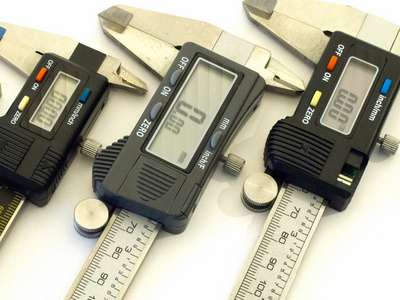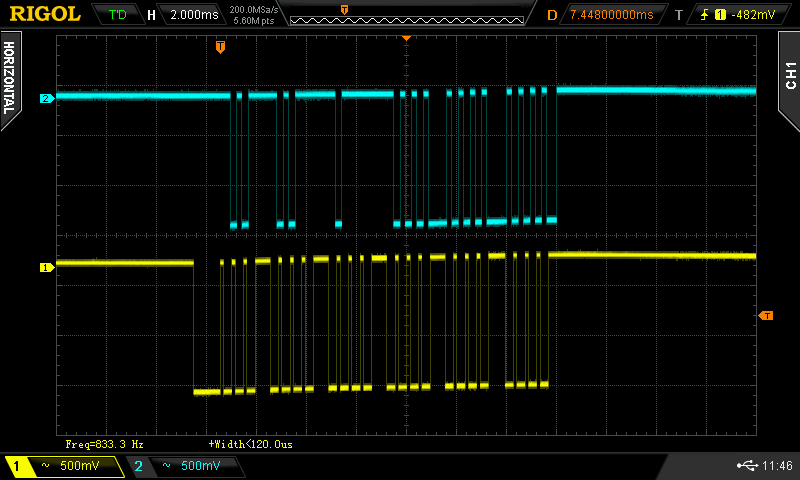Generic Chinese Digital Calipers

Over the last few decades, inexpensive generic Chinese calipers, test indicators, and other scales have become rather ubiquitous. The majority of the models use the same basic internals and come in all sorts of shapes and sizes, often selling for less than $10 (USD). As a result of their low cost and availability, digital calipers and derived linear scales might make them look like an appealing choice for an ultra low budget do-it-yourself digital readout for a small machine. Unfortunately, the majority of those calipers and scales are likely unsuitable for a practical DIY digital readout for several reasons (see below).
Important Note: This page covers only the generic Chinese digital calipers, similar to the model shown in the photo. There are newer models sold by iGaging, Shahe, and other Chinese brands. Even though they look similar to the generic digital calipers, the branded calipers are usually of better quality and use more modern electronics.
Common Models
The most ubiquitous version is the basic digital calipers sold by various discount tool outlets, online retailers, etc. They cost between $10 and $20 (USD) for the 6" size and look similar to the models shown in the photo below.

As a rule of thumb, the calipers and linear scales based on the caliper electronics use 1.5V power supply and data signal level. Just like is the case with the 48-bit Chinese linear scales, the positive side of the battery is connected to the positive side of the power supply. The calipers have very basic features, such as the "Zero" button and the support of Inches and Millimeters. There are also models that have some extra features such as the ability to display fractions in addition to Inches and Millimeters, etc.
Potential Problems
Most cheap Chinese digital calipers have a few serious shortcomings that make using them in a DRO problematic or outright impossible. The prevalence of those issues varies based on the particular manufacturer or model. Furthermore, the relevant information is seldom listed on the packaging or on the manufacturer's website and a fair bit of experimentation might be needed to determine caliper's suitability.
Power-Off Behavior
Unlike most modern linear scales and even the classic 48-bit Chinese scales, digital calipers power off completely when the display is off. This is done to save battery life since the particular implementation of the encoder used by the scales is not very energy efficient. The unfortunate side effect is that when the calipers are [accidentally] powered off and on, the position is reset to 0, which is very problematic in a DRO setup.
Auto Shut-Off
In order to extend battery life, most Chinese calipers implement some sort of auto shut-off feature. The most common case is a simple inactivity timeout that shuts off the caliper after some minutes of inactivity, but there are models that use a simple timer that starts when the scale is powered on. Since there is no way to disable this feature, calipers that implement the feature are not suitable for a practical do-it-yourself digital readout.
Data Stream Contents
The majority of the cheap calipers' data stream contains exactly what is shown on the display rather than raw position. In other words, the caliper will encode the readout in inches or millimeters in a binary format and send it down the wire. This creates a few issues. First of all, the resolution is higher in metric mode than inches, since 0.01 mm is about 0.00039". The majority of the calipers go down to 0.0005", but some round the readout to 0.001". Second, switching between Inches and Millimeters changes the data stream. While some calipers set the appropriate "units" flag, this is not always guaranteed. Calipers that have fraction display feature often fail to properly use the units flag, for example. Worse yet, some calipers have a dummy data port that looks just like a real data port but serves no practical function.
Technical Details
| Power supply voltage | 1.5V |
|---|---|
| Scale frame connection | +1.5V |
| Resolution | 0.01 mm; 0.001" or 0.0005" (varies by model) |
| Material | Stainless Steel |
| Accuracy | Varies |
| Refresh rate | 3Hz |
| Available lengths | 4", 6", 8" and 12" |
Data Protocol
Almost all inexpensive digital calipers use the BIN 6 format that represents the position as a single 24-bit stream split into six 4-bit nibbles. One nibble is used to transmit different flags, such as units, minus sign, etc. The other five are used to represent the reading in a binary format, with each nibble representing a number between 0 and 15.

There are some models that use BCD 7 format that represents the data as a single 28-bit stream broken into 7 nibbles. One nibble is used to represent the negative sign, units and the position of the decimal point. The other six represent decimal numbers from 0 to 9.
Just like the majority of the other Chinese scales, the calipers provide their own data clock and don't employ any sort of request-response scheme.
TouchDRO Connection and Compatibility
Calipers and scales that use BIN 6 protocol are supported by TouchDRO Mixed Scale Firmware version 1.0 or older. BCD 7 scales are not supported.
Chinese digital calipers use the same data port as the classic 48-bit Chinese linear scales and have the same connection requirements. I.e. since the output signal is 1.5V, they require a voltage level shifter circuit to interface with MSP430 running at 3.3V.

Pros
- Low cost and ubiquitous availability
- Stainless steel frame and encoder housing
Cons
- Low refresh rate
- Limited lengths available
- 1.5V signal level
- Prone to random position jumps
- Power-off position reset
Final Words
Inexpensive Chinese calipers and scales that use similar frames and electronics might look like an appealing option for low-cost DIY DRO. In reality, while some models might work adequately, the majority of the common models are not suited for an application. Since it's impossible to determine if a particular model exhibits the shortcomings described above without proper test equipment or some amount of experimentation, these calipers should be avoided.
